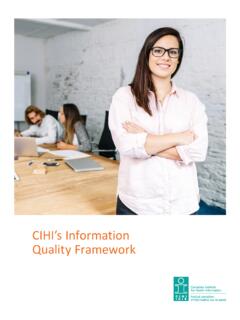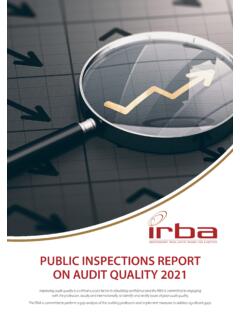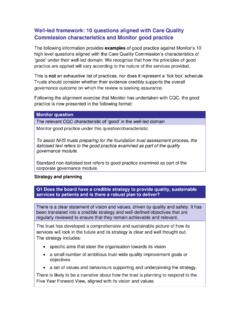Transcription of Quality Risk Management Presentation
1 Quality Risk Management Transforming Quality into a Fundamentally New Approach These slides and the content of this Presentation represent the work and opinions of the author and do not constitute official positions of Quality Risk Management Associates, LLC or any other organization. Graphics, figures and data contained herein are for illustrative purposes and are not representative of actual data. Objectives of this Presentation Transforming our approach to Quality How QRM will help us QRM Concepts QA/QC Governance Model Benefits of QRM. 2. Quality is managed between three constituencies . Management , QC and QA. The Quality Management Triangle Quality governance as part of Management Mgmt oversight Oversight Quality Quality assurance Control (QA) (QC).
2 Quality control built into Independent Quality business processes assurance through audits 3. What is a risk and what is Quality Risk Management ? Key Definitions Risk is defined as the combination of the probability of Risk occurrence of harm and the severity of that harm Quality Risk Management (QRM) is a systematic process consisting of Risk identification Risk assessment Quality Risk Risk mitigation Management Risk avoidance/reduction (QRM) Communication QRM supports better decision making by providing greater insight into risks and their impacts and helps to make proactive decisions 4. The objective of Quality risk Management is to ensure safety of patients and integrity of data Objectives of Quality Risk Management in GCP & Pharmacovigilance Safety Processes in all clinical trials and post-marketing surveillance activities Core Objectives Data Integrity of data created in these trials and activities SOP and Consistency Derived Robust Regulatory across all Transparency Objectives processes Compliance entities 5.
3 Clear need to change our approach to Quality Higher expectations of Quality across industry Internal Need for early detection of critical Quality issues Need for transparency and prioritization of Quality risks Limitations of current auditing approach, calling for range of new instruments . Need to optimize resources in teams and functions External Increasing regulatory pressure More inspections Inspections in new territories New approach to inspections: From trial/clinic-centered to systems review Growing media scrutiny of compliance, or lack thereof: Compliance is sustainability factor 6. Major challenge #1: The numbers are against us Audits cover only about 2% of clinical related activities Focus of Risk Mgmt GCP & Pharmacovigilance Entities Audit Coverage Pharmaco Pharmaco 101.
4 HQ functions Inaccurate incomplete Safety Processes 102. Affiliates data 250-300 Audits ~20,000 Entities 103 =. Partners CROs Labs Manuf . Others < 2% Audit Patient Safety Coverage Data Integrity 104. Trial Centers 7. Major challenge #2: Rising rate of regulatory inspections Early detection of risk is essential 35. 30. Num ber of Inspections 25. 20. 15. 10. 5. 0. 1996 1997 1998 1999 2000 2001 2002 2003 2004 2005 2006 2007. Local Authority Inspection - USA (FDA) FDA Foreign Inspection Local Authority Inspection - Japan Local Authority Inspection - UK. Local Authority Inspection - France Local Authority Inspection - Germany Other Inspections Source: Health Authority Analyses (Last update December 21st, 2007).
5 8. The FDA encourages Pharma Industry to develop and implement a prospective Quality Risk Management system . Quality Risk Management Initiatives at FDA'. FDA has the mandate to ensure regulatory compliance, but regulations Set only the floor not the ceiling for Quality Should support risk based approaches Quality Management always should keep the big picture in mind Analyzing the significance/ impact of Quality deviations/ risks Detecting and correcting multi-system failures first Recommended approach is to develop and implement a Quality system, structured on risk identification and Management , that is prospectively shared with and agreed to by FDA . To utilize the information that we routinely obtain during monitoring/ auditing/.
6 Inspection to improve Quality . To conduct signal detection and follow-up . Source: Adapted from Presentation of David Lepay, Senior Advisor for Clinical Science (FDA), at DIA: 43rd Annual Meeting, Atlanta 2007. 9. Changes in the regulatory environment August 2013. EMA Reflection Paper on Risk-Based Quality Management in Clinical Trials FDA Guidance Oversight of Clinical Investigations: A Risk-Based Approach to Monitoring April 2009. Q10 Pharmaceutical Quality Systems May & June 2006 ICH guidance documents recommended for adoption Q9 Quality Risk Management Q8 Pharmaceutical Development Originally manufacturing focused but now being applied to the full development process ISO 31000 (2009) Risk Management Principles and Guidelines Generic Risk Management Guidelines Applicable to any public, private or community enterprise EU GMP - Eudralex Volume 4, Annex 20, Quality Risk Management (2008).
7 Systematic approach to QRM for compliance with GMP and other Quality requirements ISO 14971 (2007) - Application Of Risk Management To Medical Devices Identify hazards associated with medical devices including in vitro diagnostics To control the risks and monitor effectiveness 10. ICH Q9 process Initiate Quality Risk Management process Risk Assessment Risk Identification Risk Analysis Risk Evaluation Risk Management Tools unacceptable Risk Communication Risk Control Risk Reduction Risk Acceptance Output / Result of the Quality Risk Management process Risk Review Review Events 11. Only a new approach to Quality Management will help to cope with these challenges Fundamental Transition in Quality Management Traditional Approach Future Requirement Detection of Individual Quality Issues Detection of Systemic Quality Issues Sample analysis of Quality risks Continuous evaluation of many/.
8 All entities and risk areas Detail information on individual Focused sets of information on functions/ sites many/ all entities Fragmented fact base on Identification of systemic Quality critical Quality issues issues based on comprehensive set of Retrospective information Prospective 12. The traditional approach of Quality Management which focuses on in- depth, comprehensive but infrequent audits is expanded by new elements: QRM assesses Quality data in a more focused and more frequent manner QRM Elements Comprehensive Classical Audits Depth &. Intermediate Richness Diagnostic Tools Key Risk 1 2 3. Indicators 4 5 6. (KRIs). Selective 7 8 9. Low Medium High < every 18 months every 6-12 months < 3months in few entities in many entities in all entities Traditional QA.
9 Frequency &. New QRM Elements Reach . 13. Analytical QRM tools which cover risks across the different entities and phases of clinical trials and safety reporting Scope of Quality Risk Management (QRM). Clinical Trial by Phases QRM Risk Area Entity Focus FPI LPI. Start-up Conduct Close-out Study Quality Risk Assessment Study / protocol Study set-up Study Quality Risk Assessment Study center Good Clinical Clinical Trial Centers /investigator site Practice Clinical Trial Centers QRM IM Tool Data Good Clinical Management /Science Study / protocol Practice Data Management /Science Review Review Data Quality Affiliate/Centers of Excellence Affiliate Study Management Affiliate/Centers of Excellence All operational areas Service Provider/CRO Service Assessment (systems, Service Providers/CROs Provider/CRO.)
10 Processes). Pharmacovigilance Drug Safety in Affiliates Affiliate Clinical safety Drug Safety Affiliates Processing QRM IM Tool Pharmacovigilance Safety Operating Centers center Safety Operations Clinical safety Med. Eval. Group 14. QRM clearly distinguishes itself from traditional Quality Management Key Aspects of Traditional Quality Management vs. QRM Approach Aspects Traditional Quality Management QRM Approach Assessment mode Ad hoc Continuous evaluation Time resolution Months - Years Days - Months Coverage (reach) Limited sample Comprehensive (all entities). Level of detail (richness) High High for determined key risk factors Continuous, through a variety of Data collection Ad hoc in context of audit activities and tools QRM reports, Diagnostic Tools Audit reports Questionnaires, Key Risk Indicators, IM Tools few # of routine audits most Most (more focused) ; Confirmatory # of specific audits few activities Full range of QRM processes and Processes Auditing & CAPA.







